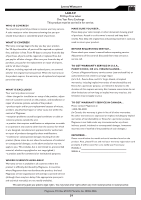Magnavox 20MF500T User Manual - Page 36
This Class B Digital Apparatus Meets All Requirements Of The Canadian - philips
 |
UPC - 961613016614
View all Magnavox 20MF500T manuals
Add to My Manuals
Save this manual to your list of manuals |
Page 36 highlights
REGULATORY FEDERAL COMMUNICATIONS COMMISSION (FCC) NOTICE (U.S. ONLY) This equipment has been tested and found to comply with the limits for a Class B digital device, pursuant to Part 15 of the FCC Rules. These limits are designed to provide reasonable protection against harmful interference in a residential installation. This equipment generates, uses and can radiate radio frequency energy and, if not installed and used in accordance with the instructions, may cause harmful interference to radio communications. However, there is no guarantee that interference will not occur in a particular installation. If this equipment does cause harmful interference to radio or television reception, which can be determined by turning the equipment off and on, the user is encouraged to try to correct the interference by one or more of the following measures: • Reorient or relocate the receiving antenna. • Increase the separation between the equipment and receiver. • Connect the equipment into an outlet on a circuit different from that to which the receiver is connected. • Consult the dealer or an experienced radio/TV technician for help. Changes or modifications not expressly approved by the party responsible for compliance could void the user's authority to operate the equipment. Use only RF shielded cable with ferrite core when connecting this monitor to a computer device. • RF shield cable with ferrite core can be obtain from multiple retail outlets or Philips Factory Service Center. • The RF shield cable with ferrite core part number is 3138 198 71441. • If your RF shield cable without ferrite core, you can obtain the ferrite core from Philips Factory Service Center, installation as following. 1. Open the ferrite core. 2. Locate the video connector that goes to the computer and plugs into the unit. Place the ferrite core as close to the video connector as possible, as shown in the figure below. Interface cable Video connector Ferrite Core 3. Lock the ferrite core. 4. Place two cable tie wrap on either side of the ferrite core to prevent it from sliding down the cable, as shown in the figure below. Ferrite Core Installation To ensure compliance of this unit to the Class B limits of the FCC Rules, Part 15, Subpart B. This kit must be utilized when "non-ferrited" video cables are used with this unit. This instruction sheet gives the details for proper installation. Additional FCC information may be found in the radio frequency interference statement located in the user's manual. Cable tie 5. Draw the tie wraps tight and cut off the excess leads. To prevent damage which may result in fire or shock hazard, do not expose this appliance to rain or excessive moisture. THIS CLASS B DIGITAL APPARATUS MEETS ALL REQUIREMENTS OF THE CANADIAN INTERFERENCE-CAUSING EQUIPMENT REGULATIONS. 36













